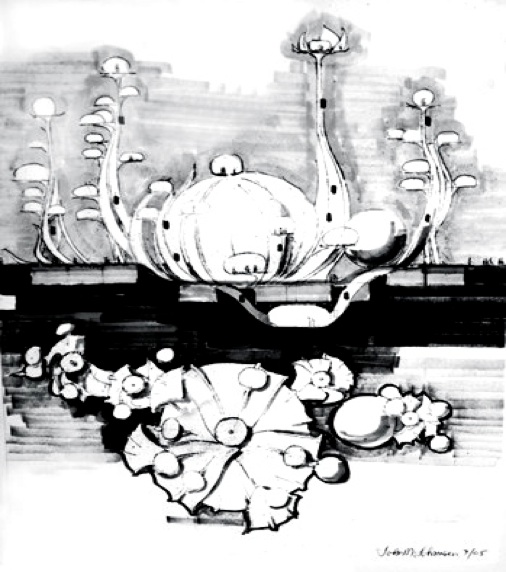NANOARCHITECTURE: A DISCOURSE by John M. Johansen FAIA
From the outset, it should be understood that molecular-engineered buildings are still theoretical in nature.
Though the projects that I have developed over the past decade are indeed based upon technologies that,
before long, will be realized, the applications of molecular engineering, architectural included, remain speculative.
Molecular Nanotechnology (MNT) represents a new phase in the evolution of manmade structures. The central
thesis that nanotechnology is "capable of producing almost any chemically stable structure that can be specified"
was first advanced by the physicist Richard Feynman in 1945. Prompted by Feynman, physicist-designer
William Katavolos expanded the study of MNT to the growth of architecture, foreseeing the production of a
large floating city. Katavolos remarks, "We are rapidly gaining the necessary knowledge of the molecular
structure of these chemicals with the necessary techniques that will lead to the productions of materials
that will have a specific program of behavior built into them."
Advanced studies link the processes of DNA with molecular growth. James Watson and Francis Crick
discovered that DNA governs the continuity and growth of all living things. In nature, DNA directs ribosomal
machinery to build other machines. Physicist K. Eric Drexler, considered the founding father of nanotechnology, has
advanced realistic procedures for designing simulated molecular structures. Accordingly, Drexler proposes that artificial DNA, or coding devices, be developed and employed in structuring matter to the service of mankind. Within the molecular structure, atoms of various chemical make-ups are selected, assembled in particular patterns, and programmed to replicate themselves thus enabling immense workforces to produce products of almost any design. The molecular structure harnesses the energies from chemicals and electricity, rather than conventional human labor and current major power sources.
Progress to Date
Notable advances have been made in the allied field of biochemistry. Genetic engineers have programmed bacteria to make proteins used in human growth hormone and insulin. In the field of computer-aided design, the National Science Foundation has supported research for developing molecular computers, and the Japanese government has launched a program to develop microscopic, self-assembling molecular motors. These instruments are essential elements in the nanotechnological enterprise.
At the forefront of research and development are the Palo Alto-based Foresight Institute and its affiliate, the Institute of Molecular Manufacturing, which were formed specifically to develop molecular assembler-robots programmed to build. The Nanotechnology Development Corporation of NASA has also invested extensively in the research of MNT and its applications for construction in space. Though a self-assembling molecule has yet to be produced, its development seems inevitable.
This research has lead scientists to develop products based on MNT for future consumption by ordinary people. At the Ames laboratory at NASA, J. Storrs Hall has designed a simulated 'Air Car" that can be controlled remotely and with little human input. Hall's "Air Car" is designed specifically to prompt further experimentation in aeronautics. Likewise, it is my intention that the projects in this book stimulate advances in the building industry.
Implications for the Future
The implications of this new technology are vast. As Kai Wu has written: "Imagine a technology so powerful that it will allow such feats as desktop manufacturing, cellular repair, artificial intelligence, inexpensive space travel, clean abundant energy, environmental restoration; a technology so portable that everyone can reap its benefits-which will radically change our economic and political systems-and so imminent that most of us will see its impact within our lifetimes."
Nanotechnology will soon change industrial production by introducing labor-free manufacturing. This will directly influence our health, welfare, comfort, and prosperity. The molecular assembler breakthrough will transform our entire manufacturing process; for this, we must prepare. As with previous technological revolutions, MNT will present new ways of thinking about society and ourselves, and exact the same moral responsibilities.
Feasibility
Time, as a factor of molecular growth, is of crucial importance. The slow pace of cellular growth in nature is not comparable to the demands of modern manufacturing, marketing, and consumption. However, it is predicted that artificial growth by MNT will greatly outpace both that of nature and present manufacturing. Drexler remarks that with MNT, "a vast number of replicators will produce assemblers by the ton," which will in turn allow for rapid production. The replicators, when grouped in what theorist Ralph Merkle has called a "Convergent Assembly," form molecular building parts, or "bricks," that can be assembled into larger parts. Groups of these could then be assembled into still larger parts. Within a few minutes, a thirty stage convergent assembly could produce a final product of one meter from material initially one manometer in size.
Another consideration is cost. Merkle states, "Common elements like hydrogen, carbon, nitrogen, oxygen, aluminum, and silicone are best sources for constituting the bulk of most structures, and because these elements can be taken in abundance from earth, water, and air, raw materials will be dirt cheap." The cost of molecular engineering-minus licensing fees, insurance, and business expenses-is comparable to the cost of creating plastic or industrial chemicals. Labor constitutes a minor factor within MNT; excepting costs for the development of computer software, MNT is labor-free.
Drexler continues, "it seems that the feasibility of nanotechnology and molecular assemblers is to be taken seriously -- for one, existing molecular machines already serve us as basic functions, and two, that parts serving these basic functions can be combined to build complex machines--since chemical reactions can bond atoms together in diverse ways, and molecular machines can direct chemical reactions according to programmed instructions." He adds that "assemblers are definitely feasible. It may take some years for the assemblers to emerge, but their emergence seems almost inevitable."
Proposal
I have, up to this point, presented basic research. Subsequently, it is my challenge and responsibility to address matters of applied science; matters of technology by which inventions, devices, and useful products might be produced. In doing so, I express my reverence for pure science, but from here on, I am my own man.
Is the production of a building-size product through MNT possible? To what extent is this new building method applicable to habitable structures? Processes of molecular growth within a sealed factory vat are quite possible. However, increasing the vats to accommodate buildings the size of ships is not a practical solution. We have little choice but to turn out building elements of a standard dimension to be transported and assembled in the most conventional way.
The essence of my proposal is molecular "growth" out of and beyond the confines of the vat. In the early stages of molecular growth processes, small molecules survive only in a sealed vat where an entactic environment is assured. However, it is likely that these perishable protein molecules will build larger, more durable molecules that will withstand and survive in the external environment. This growth, development from simple to complex molecules, from inside to outside the vat, is the critical and essential assumption of my proposal. It is only in this way that the production of large products can be realized.




